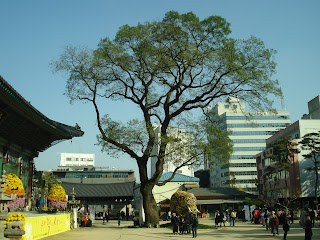Gyeonhuigung Palace was originally built over six years between 1617 and 1623. It was constructed as a detached royal villa, where kings of the Joseon Dynasty stayed during their daily excursions. During the Japanese occupation most of the structures within the Palace were destroyed and the Palace was diminished to half of its original size. In 1980 the site of the Palace was designated a Historic Site and in turn the Seoul Metropolitan Government excavated the old site to restore its major structures so it is much smaller than it originally was. In 2002 it was opened to the public. The pictures above are a sample of pictures I took there with the rest of them posted on Facebook. It's a nice place but not nearly as impressive as a lot of the bigger temples in Seoul.
Seodaemun Prison was the most notorious of the prisons built by the Japanese during the Japanese occupation of Korea from 1910 - 1945. It's kind of an eerie place to visit with the small prison cells and the imposing red bricks of the buildings and the prison walls themselves. It had seperate and distinct buildings for lepers and for executions as well. After Korea gained independence from Japan the Korean government in turn used the prison itself to imprison political dissidents and protestors. Korea did not become a true democracy until 1980 so although it was initially built and used by the Japanese later the Korean government used it imprisoning its own citizens. It was opened to the public as the Seodaemun Prison History Hall in 1988. The first picture above is the entrance to the prison. The second picture is the Execution Building while the poplar tree in front of it on the left is referred to as the "wailing tree", on account of the large number of prisoners who clung to it as a last means of resistance crying and pleading before being taken into the Execution Building. The third picture is of the Corpse Removal Exit where bodies were disposed of in secret. On a side note the tunnel actually runs under a huge apartment complex next door which has been kept as a secret from the general population. The rest of the pictures can be found on Facebook.
Unhyeongung Palace was the house in which King Gojong, the 26th king of Joseon lived before he acceded to the throne. It was originally built in 1864 and was repaired in 1996.The rest of the pictures of Unhyeongung can befound on Facebook.
The last place I visited on Sunday was Jogyesa Temple. This is the headquarters of the Jogye sect which is Korea's largest Buddhist denomination. It was built in 1910. The rest of the pictures can be found on Facebook.
CHOENAN DUDE













No comments:
Post a Comment